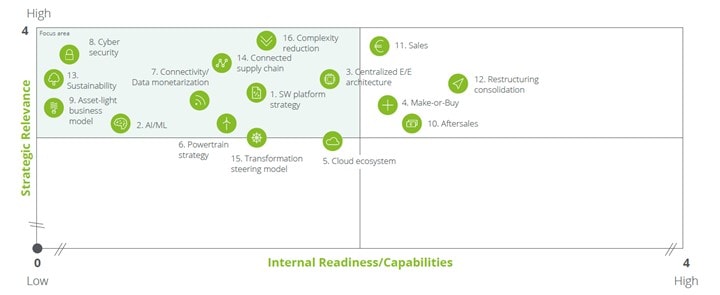Article
Supplier Ecosystems in the Truck Industry
Creating partner ecosystems is critical for transformation success
Published: 10 February 2023
The truck business is undergoing radical change and faces pressing challenges: From ongoing consolidation and supply chain shortages related to the pandemic and the war in Ukraine to a large-scale transformation driven by long-term, overarching trends and disruptive innovations. This Point of View Building Supplier Ecosystems in the Truck Industry describes why supplier ecosystems play a decisive role for the future success of the truck industry.
Basic value shifts in the truck industry
There are four strategic trends that require a large-scale transformation from the entire industry: new drivetrains, digitalization, connectivity and autonomous driving will shape the future of road transport. To succeed, companies must follow two basic value shifts. On the one hand, they have to upstream to a new agile and digitized production system. On the other hand, the industry has to downstream to create added value to its customers by way of services. Much of the groundwork has been laid, but there is still work to be done: Deloitte research shows that most companies of the automotive and the truck industry are some three to six years into their transformation journey.
The importance of ecosystems in digitization
This Point of View focuses on the upstream transformation of the truck industry, specifically on supplier ecosystems. A 2021 Deloitte survey identified 16 transformational action areas. Most of these are strongly driven by IT systems and software.
Figure: Overview Burning Platforms

Source: Deloitte expert interviews
Moreover, the need to collaborate more intensively is paramount to almost every digital initiative, with partners in development, production, procurement, sales, and service. The global Deloitte databank shows that the more digital and advanced automotive suppliers become, the more collaborative and connected they are. The same goes for the truck industry: Advanced digitalization and collaboration with network partners are interdependent and mutually amplify each other.
Figure: Deloitte Digital Maturity Index Automotive/EBIT impact

In procurement, digitalization prompts a move away from traditional supply chains towards more integrated supply networks with a set of partners. Traditional supply chains have discrete processes for development, planning, sourcing and delivering. The end buyer defines the processes and also owns the collaboration (IT) system. Within an integrated supply network, more responsibilities are shifted to the partners, with an increased information exchange between them. But still the end buyer owns the processes and the platform. In a supply ecosystem as next evolutionary step, the platform and the processes are shared between the partners. So far, only very few companies in all industries have reached this level.
Figure: From a Traditional Supply Chain to a Supply Ecosystem

The ecosystem challenge
A Deloitte survey from February 2022 among German manufacturing firms shows there are many goals for supply ecosystems, all of which are all practically equally important:
- Fix set of ecosystem partners
- Modular build of the ecosystem
- Complementary build of the ecosystem
- Know-how transfers
- Common governance
- Common business activities
For companies, this means they need to make significant efforts at the outset and should not focus on moving from the traditional supply chain to a full supply ecosystem in one leap, but rather approach the task step by step.
Core elements of successful ecosystems
The German automotive industry is currently developing a common ecosystem platform for the industry by the name of Catena X, but so far there is no comparable activity in the truck industry. The biggest technical challenge for all partners is to create a technological basis for connected value creation that integrates their disparate systems landscapes.
Ecosystems enable cost avoidance and cost reduction effects, additional revenue opportunities, margin improvement benefits as well as agility improvements. Each partner in an ecosystem must find a way to quantify the business impacts and must ensure there is a fair share of profits.
Data sharing within an ecosystem requires strong mutual trust among all partners. There must be a governance system that is flexible enough to allow for constant improvements, but that also makes sure that profits are shared according to the individual contributions.
Building a supply chain ecosystem is no easy feat and takes time, but there are no alternatives. Supplier ecosystems will play a major role in shaping the change of the truck industry within the next ten to twenty years.


